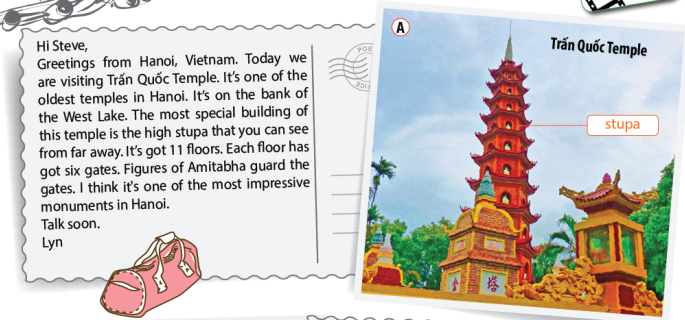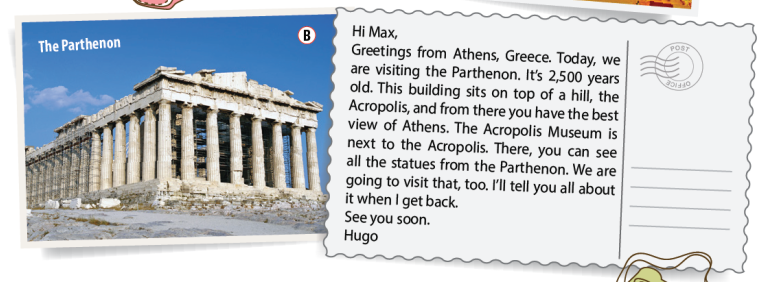Tiếng Anh 7 Unit 5 5f. Skills
1. Look at the monuments in the pictures. Where is each? Listen and read to find out. 2. Reading the postcards again. Which monument, A or B … 3. Ask questions based on the texts. 4. Listen and repeat. Which wonder is the oldest? 5. Use the information in Exercise 4 to talk about the wonders as in the example. 6. Listen to a presentation and complete the gaps. 7. Imagine you are on holiday visiting a wonder. Write a postcard to your English penfriend (about 60- 80 words.) Include where you are
Bài 1
Listening and Reading (Phần nghe và phần đọc)
1. Look at the monuments in the pictures. Where is each?
Listen and read to find out.
(Nhìn vào các di tích trong ảnh. Mỗi di tích đấy ở đâu? Nghe và đọc để tìm hiểu.)


Hi Steve,
Greetings from Hanoi, Vietnam. Today we are visiting Trấn Quốc Temple. It’s one of the oldest temples in Hanoi. It’s on the bank of the West Lake. The most special building of this temple is the high stupa that you can see from far away. It’s got 11 floors. Each floor has got six gates. Figures of Amitabha guard the gates. I think it’s one of the most impressive monuments in Hanoi.
Talk soon.
Lyn
Hi Max,
Greetings from Athens, Greece. Today, we are visiting the Parthenon. It’s 2, 500 years old. This building sits on top of a hill, the Acropolis, and from there you have the best view of Athens. The Acropolis Museum is next to the Acropolis. There, you can see all the statues from the Parthenon. We are going to visit that, too. I’ll tell you all about it when I get back.
See you soon.
Hugo.
Phương pháp giải:
Chào Steve,
Gửi lời chào từ Hà Nội, Việt Nam. Hôm nay chúng tôi đến thăm đền Trấn Quốc. Đây là một trong những ngôi chùa cổ nhất ở Hà Nội. Nó nằm trên bờ Hồ Tây. Bạn có thể nhìn thấy từ xa công trình đặc biệt nhất của chùa là bảo tháp cao. Nó có 11 tầng. Mỗi tầng có sáu cổng. Ảnh của phật A Di Đà trấn giữ các cổng. Tôi nghĩ đây là một trong những di tích ấn tượng nhất ở Hà Nội.
Trả lời thư sớm nhé.
Lyn
Chào Max,
Gửi lời chào từ Athen, Hy Lạp. Hôm nay, chúng tôi thăm đền Parthenon. Nó đã 2500 năm tuổi. Tòa nhà này nằm trên đỉnh đồi, Acropolis, và đứng từ đáy bạn có được tầm nhìn ra Athens đẹp nhất. Bảo tàng Acropolis nằm cạnh Acropolis. Ở đó, bạn có thể nhìn thấy tất cả các bức tượng tử Parthenon. Chúng tôi cũng sẽ đến thăm nơi đó. Tôi sẽ kể cho cậu nghe tất cả khi tớ quay về.
Mong sớm gặp nhau.
Hugo
Lời giải chi tiết:
A. Hanoi, Vietnam (Hà Nội, Việt Nam)
B. Athens, Greece (Athens, Hy Lạp)
Bài 2
2. Reading the postcards again. Which monument, A or B …
(Đọc lại bưu thiếp. Đâu là di tích, A hoặc B …)
1. has a lot of floors? ロ
2. has a museum nearby? ロ
3. is on the bank of a lake? ロ
4. gives you a great view of the city? ロ
Lời giải chi tiết:
|
1. A |
2. B |
3. A |
4. B |
1. A.
has a lot of floors (có nhiều tầng).
Thông tin: “It’s got 11 floors.” (Nó có 11 tầng.)
2. B
has a museum nearby (ở gần một bảo tàng.)
Thông tin: “The Acropolis Museum is next to the Acropolis.”
(Bảo tàng Acropolis nằm cạnh Acropolis.)
3. A
is on the bank of a lake.
Thông tin: “It’s on the bank of the West Lake.”
(Nó nằm trên bờ hồ Tây.)
4. B
gives you a great view of the city.
Thông tin: “This building sits on top of a hill, the Acropolis, and from there you have the best view of Athens.”
(Tòa nhà này nằm trên đỉnh đồi, Acropolis, và đứng từ đáy bạn có được tầm nhìn ra Athens đẹp nhất.)
Bài 3
3. Ask questions based on the texts.
(Đặt câu hỏi dựa vào các đoạn văn bản.)
A: Where is Lyn?
B: She’s in Hanoi, Vietnam.
A: What is she doing today?
B: She’s visiting Trấn Quốc Temple.
(A: Lyn ở đâu?
B: Cô ấy ở Hà Nội, Việt Nam
A: Cô ấy đang làm gì?
B: Cô ấy đến thăm đền Trấn Quốc.)
Lời giải chi tiết:
A: Where is Trấn Quốc Temple?
B: It’s on the bank of the West Lake?
A: What is the most special building of the temple?
B: It’s the high stupa, etc.
A: Where is Hugo?
B: He’s in Athens, Greece.
A: What is he doing today?
B: He is visiting the Parthenon today.
A: How old is the Parthenon?
B: It’s 2500 years old.
A: Where is the Parthenon?
B: It’s on the top of the Acropolis Hill, etc.
(A: Đền Trấn Quốc ở đâu?
B: Ở trên bờ Hồ Tây à?
A: Đâu là tòa nhà đặc biệt nhất của đền?
B: Đó là bảo tháp cao, …
A: Hugo ở đâu?
B: Anh ấy ở Athen, Hy Lạp.
A: Anh ấy làm gì hôm nay?
B: Anh ấy đến thăm Parthenon.
A: Parthenon bao nhiêu tuổi?
B: Nó đã 2500 năm tuổi.
A: Parthenon ở đâu?
B: Ở trên đỉnh ngọn đồi Acropolis, …)
Bài 4
Vocabulary (Từ vựng)
Wonders of the World (Cảnh đẹp khắp thế giới)
4. Listen and repeat. Which wonder is the oldest?
(Nghe và nhắc lại. Đâu là cảnh đẹp lâu đời nhất?)

Phương pháp giải:
Taj Mahal- Agra, India- 1648- mausoleum: Taj Mahal- Agra, Ấn Độ- 1648- lăng
Colosseum- Italy- 70 C.E- stadium: Colosseum- Ý- năm 70 sau Công Nguyên- sân vận động
Petra- Jordan- 3rd century B.C.E- city: thành phố Petra- Jordan- thế kỷ thứ 3 trước Công Nguyên- thành phố
Great Pyramid of Giza- Egypt- 2580- 2560 B.C.E- tomb: Đại kim tự tháp Giza- Ai Cập- 2580- 2560 trước Công Nguyên- lăng mộ
Chichen Itza- Mexico- 400 C.E- Mayan city: Chichen Itza- Mexico- năm 400 sau Công Nguyên- thành phố của người Maya
Sigiriya- Sri Lanka- 5th century- fortress: Sigiriya- Sri Lanka- thế kỷ thứ 5- pháo đài
Lời giải chi tiết:
The Great Pyramid of Giza is the oldest.
B.C.E stands for “Before the Common Era”. According to this system, we count time backwards “Before the Common Era” (B.C.E.) and forwards in “the Common Era”. (C.E)
The 1st century included the years 1- 100 (there was no year zero). The 2nd century included the years 101- 200. Similarly, when we say the 2nd century B.C.E, we are referring to the years 200- 101 B.C.E.
(Đại kim tự tháp Giza lâu đời nhất.
B.C.E viết tắt cho “Trước Công Nguyên”. Theo hệ thống này, chúng ta đếm ngược thời gian “Trước Công Nguyên” (B.C.E) và ngược lại trong “Công Nguyên”. (C.E) Thế kỷ thứ 1 bắt đầu từ năm 1- 100 (không có năm 0). Thế kỷ thứ 2 từ năm 101- 200. Tương tự, khi chúng ta nói thế kỷ 2 TCN, chúng ta đang đề cập đến những năm 200- 101 TCN.)
Bài 5
Speaking (Phần nói)
5. Use the information in Exercise 4 to talk about the wonders as in the example.
(Sử dụng thông tin ở bài 4 để nói về cảnh đẹp trong các ví dụ.)
The Taj Mahal is mausoleum in Agra, India. People built it in 1648.
(Taj Mahal là lăng ở Agra, Ấn Độ. Mọi người xây dựng nó vào năm 1648.)
Lời giải chi tiết:
2. The Colosseum is an ancient stadium in Italy. People built in 70 C.E
(Colosseum là một sân vận động cổ ở Ý. Mọi người xây dựng nó vào năm 70 sau Công Nguyên.)
3. Petra is an ancient city in Jordan. People built it in the 3rd century B.C.E
(Petra là một thành phố cổ ở Jordan. Mọi người xây dựng nó vào thế kỷ thứ 3 trước Công Nguyên.)
4. The Great Pyramid of Giza is a tomb in Egypt. People built it from 2580 to 2560 B.C.E
(Đại kim tự tháp Giza là một lăng mộ ở Ai Cập. Mọi người xây dựng nó từ năm 2580 đến 2560 trước Công Nguyên.)
5. Chichen Itza is a Mayan city in Mexico. People built it in 400 C.E.
(Chichen Itza là một thành phố của người Maya ở Mexico. Mọi người xây dựng nó vào năm 400 sau Công Nguyên.)
6. Sigiriya is a fortress in Sri Lanka. People built it in the 5th century.
(Sigiriya là một pháo đài ở Sri Lanka. Mọi người xây dựng nó vào thế kỷ thứ 5.)
Bài 6
Listening (Phần nghe)
6. Listen to a presentation and complete the gaps.
(Nghe đoạn thuyết trình và hoàn thành các chỗ trống.)
Machu Picchu is in 1) ___________ in South America. It is an ancient 2) ___________ and it dates from 1450. An American historian discovered it in 3) ___________. Today, around 4) ___________ people visit it every year.
Lời giải chi tiết:
Machu Picchu is in 1) Peru in South America. It is an ancient 2) city and it dates from 1450. An American historian discovered it in 3) 1450. Today, around 4) 1, 5 million people visit it every year.
(Machu Picchu ở Peru nằm trong Nam Mỹ. Nó là một thành phố cổ và được xây dựng từ năm 1450. Một nhà khảo cổ học người Mỹ đã khám phá ra nó vào năm 1450. Ngày nay, có khoảng 1, 5 triệu người ghé thăm nơi này mỗi năm.)
Bài 7
Writing (Phần viết)
7. Imagine you are on holiday visiting a wonder. Write a postcard to your English penfriend (about 60- 80 words.) Include where you are, the information about the wonder and when you are coming back.
(Tưởng tượng bạn đang đến thăm một cảnh đẹp vào kì nghỉ. Viết một tấm bưu thiếp cho bạn qua thư bằng tiếng Anh (khoảng 60- 80 từ.). Bao gồm bạn đang ở đâu, thông tin về cảnh đẹp và khi nào bạn quay về.)
Lời giải chi tiết:
Hi Trang,
Greetings from Peru. Weather’s great! Today we’re visiting Machu Picchu. This ancient city dates from 1450. All the buildings are granite. The stones have nothing holding them together, but they stay strong because there are no spaces between the stones. To reach it, we walked along the Inca Trail. It’s a difficult path, but it’s amazing. Can’t wait to show you photos.
Coming back next Saturday.
Jim
(Chào Trang,
gửi lời chào từ Peru. Thời tiết rất tuyệt! Hôm nay chúng tôi đi thăm Machu Picchu. Đây là thành phố cổ được xây dựng từ 1450. Tất cả các tòa nhà đều được lát gạch granit. Các viên đá không có gì giữ chúng lại với nhau, nhưng chúng vẫn bền vững vì không có khoảng cách giữa các viên đá. Để đến được đây, chúng tôi đi dọc theo đường mòn Inca. Đó là một chặng đường gian nan, nhưng nó thật tuyệt vời. Nóng lòng muốn cho bạn xem ảnh lắm.
Tớ sẽ quay về vào thứ bảy tới.
Jim)












